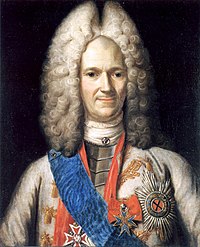
Catherine IAlekseyevna Mikhailova; born Marta Samuilovna Skavronskaya; 15 April [O.S. 5 April] 1684 – 17 May [O.S. 6 May] 1727) was the second wife and Empress consort of Peter the Great, whom she succeeded as Empress of Russia, ruling from 1725 until her death in 1727.

Elizabeth or Elizaveta Petrovna was Empress of Russia from 1741 until her death in 1762. She remains one of the most popular Russian monarchs because of her decision not to execute a single person during her reign, her numerous construction projects, and her strong opposition to Prussian policies.
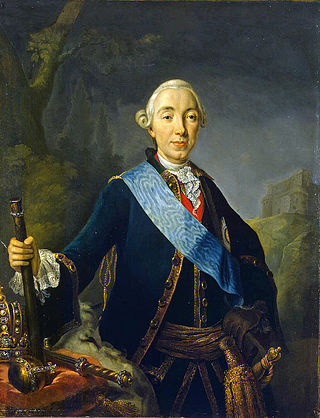
Peter III Fyodorovich was Emperor of Russia from 5 January 1762 until 9 July of the same year, when he was overthrown by his wife, Catherine II. He was born in the German city of Kiel as Charles Peter Ulrich of Schleswig-Holstein-Gottorp, the grandson of Peter the Great and great-grandson of Charles XI of Sweden.

Peter II Alexeyevich was Emperor of Russia from 1727 until 1730, when he died at the age of 14. He was the only son of Tsarevich Alexei Petrovich and Charlotte Christine of Brunswick-Lüneburg. After Catherine I's death, Alexander Menshikov controlled Peter II, but was thwarted by his opponents and exiled by Peter. Peter was also influenced by favorites like Prince Aleksey Dolgorukov, leading to a neglect of state affairs and the tightening of serfdom. Peter's reign was marked by disengagement, disorder, and indulgence. He was engaged to Ekaterina Dolgorukova, but died suddenly of smallpox before the marriage, thus making him the last male agnatic member of the House of Romanov.
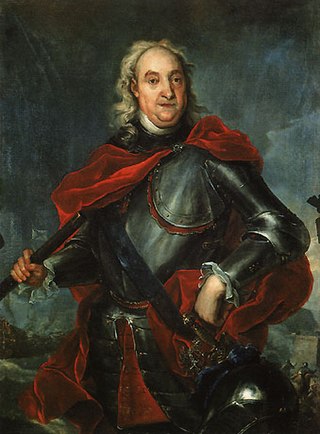
Count Fyodor Matveyevich Apraksin was one of the first Russian admirals, governed Estonia and Karelia from 1712 to 1723, was made general admiral (1708), presided over the Russian Admiralty from 1717 to 1728 and commanded the Baltic Fleet from 1723.
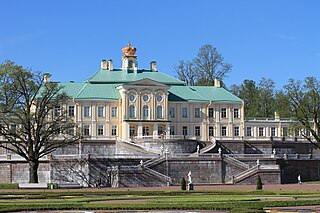
Oranienbaum is a Russian royal residence, located on the Gulf of Finland west of St. Petersburg. The Palace ensemble and the city centre are UNESCO World Heritage Sites.
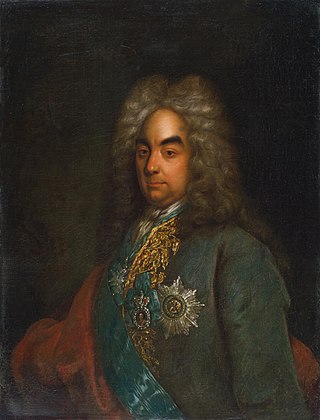
Count Pyotr Andreyevich Tolstoy was a Russian statesman and diplomat, prominent during and after the reign of Peter the Great. He was the ancestor of all the Counts Tolstoy, including the novelist Leo Tolstoy and Alexei Tolstoy the writer. His wife was Solomonida Timofeevna Dubrovskaya born 1660 and died 1722; he had two sons with her, Ivan and Peter. Both his sons died in exile with him the year before his own death. He was, however, survived by many grandchildren: the family was recalled by the Empress Elizabeth, daughter of Peter the Great in 1760, and had all honors and land restored.
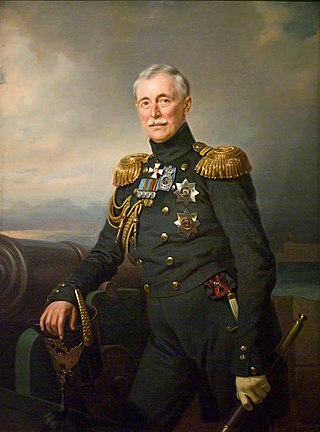
Prince Alexander Sergeyevich Menshikov was a Russian nobleman, military commander and statesman. He was made adjutant general in 1817 and admiral in 1833.

Beryozovo is an urban locality and the administrative center of Beryozovsky District of Khanty-Mansi Autonomous Okrug, Russia, located on the Ob River. Population: 7,287 (2010 Census); 7,085 (2002 Census); 7,573 (1989 Soviet census).
António Manuel de Vieira, known in Russia as Count Anton Manuilovich Devier, was one of Peter I's foreign associates, who proved to be an efficient administrator in St Petersburg and Siberia. He was St. Petersburg's first chief of police and was identified as a main rival of Alexander Danilovich Menshikov at Catherine I's court. De Vieira was the father of Peter Devier.

Grand Duchess Anna Petrovna of Russia was the eldest daughter of Emperor Peter I of Russia and his wife Empress Catherine I. Her younger sister, Empress Elizabeth, ruled between 1741 and 1762. While a potential heir in the reign of her nephew Peter II, she never acceded to the throne due to political reasons. However, her son Peter III became Emperor in 1762, succeeding Elizabeth. She was the Duchess Consort of Holstein-Gottorp by marriage. She was born in Moscow and died in Kiel in her youth, at the age of 20.
The Supreme Privy Council of Imperial Russia, founded on 19 February 1726 and operative until 1730, originated as a body of advisors to Empress Catherine I.

The Imperial Order of Saint Catherine was an award of Imperial Russia. Instituted on 24 November 1714 by Peter the Great on the occasion of his marriage to Catherine I of Russia. For the majority of the time of Imperial Russia, it was the only award for women; the Insignia of Saint Olga existed briefly from 1916 to 1917, but ceased with the fall of the Romanov dynasty.

Archangelgorod Governorate was an administrative-territorial unit (guberniya) of the Tsardom of Russia and the Russian Empire, which existed from 1708 until 1780. Its seat was in Archangel (Arkhangelsk). The governorate was located in the north of the Russian Empire and bordered Siberia Governorate in the east, Kazan Governorate in the southeast, Moscow and Ingermanland Governorates in the southwest, Sweden in the west, and Norway in north-west. In the north, the governorate was limited by the White and Barents Seas.
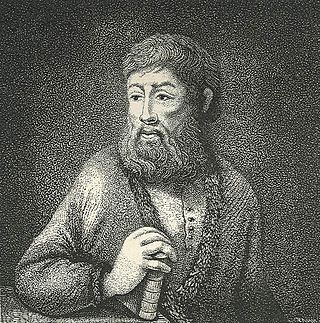
Count Nikita Moiseevich Zotov was a childhood tutor and lifelong friend of Russian Tsar Peter the Great. Historians disagree on the quality of Zotov's tutoring. Robert K. Massie, for example, praises his efforts, but Lindsey Hughes criticizes the education that he gave to the future tsar.

During the Great Northern War, the fortress of Tönning in the territory of Holstein-Gottorp, an ally of the Swedish Empire, was besieged twice. Denmark-Norway was forced to lift the first siege in 1700, but a combined force of the anti-Swedish coalition successfully besieged and took Tönning in 1713–1714.

Princess Maria Alexandrovna Menshikova was a daughter of Aleksandr Danilovich Menshikov, the favourite of Peter I of Russia.
Prince Aleksandr Aleksandrovich Menshikov was a son of Prince Menshikov who, at one stage, was betrothed to Grand Duchess Natalya Alexeyevna, a granddaughter of Peter the Great. He later served as an officer in the Russian Imperial Army.

Events from the year 1729 in Russia
Varvara Mikhailovna Arsenyeva, was a Russian courtier and mistress of Peter the Great.


